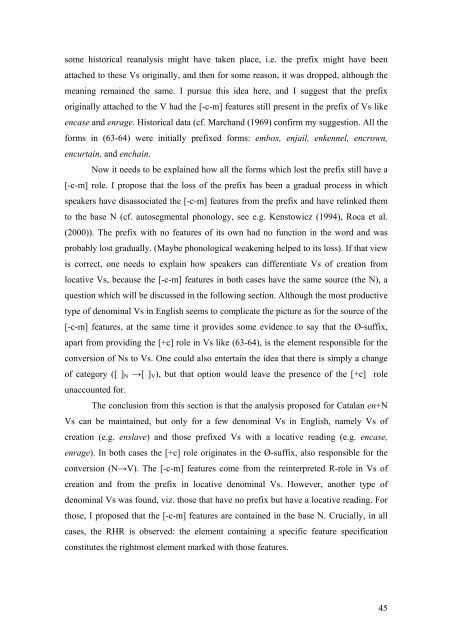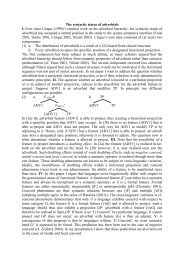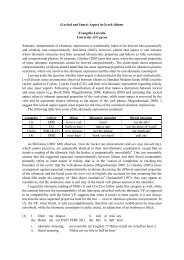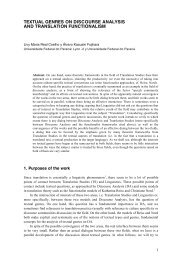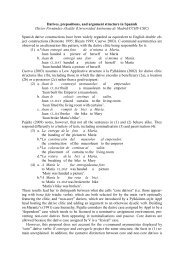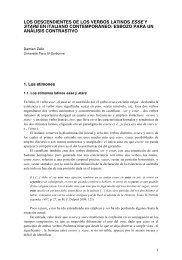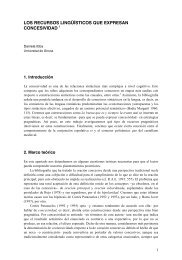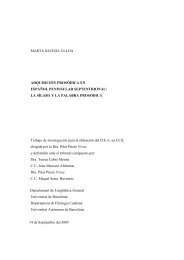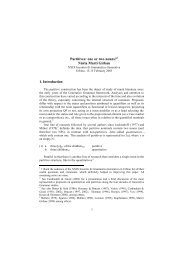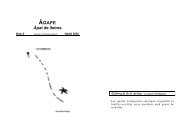Prefixation in English and Catalan - Departament de Filologia ...
Prefixation in English and Catalan - Departament de Filologia ...
Prefixation in English and Catalan - Departament de Filologia ...
Create successful ePaper yourself
Turn your PDF publications into a flip-book with our unique Google optimized e-Paper software.
some historical reanalysis might have taken place, i.e. the prefix might have been<br />
attached to these Vs orig<strong>in</strong>ally, <strong>and</strong> then for some reason, it was dropped, although the<br />
mean<strong>in</strong>g rema<strong>in</strong>ed the same. I pursue this i<strong>de</strong>a here, <strong>and</strong> I suggest that the prefix<br />
orig<strong>in</strong>ally attached to the V had the [-c-m] features still present <strong>in</strong> the prefix of Vs like<br />
encase <strong>and</strong> enrage. Historical data (cf. March<strong>and</strong> (1969) confirm my suggestion. All the<br />
forms <strong>in</strong> (63-64) were <strong>in</strong>itially prefixed forms: embox, enjail, enkennel, encrown,<br />
encurta<strong>in</strong>, <strong>and</strong> encha<strong>in</strong>.<br />
Now it needs to be expla<strong>in</strong>ed how all the forms which lost the prefix still have a<br />
[-c-m] role. I propose that the loss of the prefix has been a gradual process <strong>in</strong> which<br />
speakers have disassociated the [-c-m] features from the prefix <strong>and</strong> have rel<strong>in</strong>ked them<br />
to the base N (cf. autosegmental phonology, see e.g. Kenstowicz (1994), Roca et al.<br />
(2000)). The prefix with no features of its own had no function <strong>in</strong> the word <strong>and</strong> was<br />
probably lost gradually. (Maybe phonological weaken<strong>in</strong>g helped to its loss). If that view<br />
is correct, one needs to expla<strong>in</strong> how speakers can differentiate Vs of creation from<br />
locative Vs, because the [-c-m] features <strong>in</strong> both cases have the same source (the N), a<br />
question which will be discussed <strong>in</strong> the follow<strong>in</strong>g section. Although the most productive<br />
type of <strong>de</strong>nom<strong>in</strong>al Vs <strong>in</strong> <strong>English</strong> seems to complicate the picture as for the source of the<br />
[-c-m] features, at the same time it provi<strong>de</strong>s some evi<strong>de</strong>nce to say that the Ø-suffix,<br />
apart from provid<strong>in</strong>g the [+c] role <strong>in</strong> Vs like (63-64), is the element responsible for the<br />
conversion of Ns to Vs. One could also enterta<strong>in</strong> the i<strong>de</strong>a that there is simply a change<br />
of category ([ ]N →[ ]V), but that option would leave the presence of the [+c] role<br />
unaccounted for.<br />
The conclusion from this section is that the analysis proposed for <strong>Catalan</strong> en+N<br />
Vs can be ma<strong>in</strong>ta<strong>in</strong>ed, but only for a few <strong>de</strong>nom<strong>in</strong>al Vs <strong>in</strong> <strong>English</strong>, namely Vs of<br />
creation (e.g. enslave) <strong>and</strong> those prefixed Vs with a locative read<strong>in</strong>g (e.g. encase,<br />
enrage). In both cases the [+c] role orig<strong>in</strong>ates <strong>in</strong> the Ø-suffix, also responsible for the<br />
conversion (N→V). The [-c-m] features come from the re<strong>in</strong>terpreted R-role <strong>in</strong> Vs of<br />
creation <strong>and</strong> from the prefix <strong>in</strong> locative <strong>de</strong>nom<strong>in</strong>al Vs. However, another type of<br />
<strong>de</strong>nom<strong>in</strong>al Vs was found, viz. those that have no prefix but have a locative read<strong>in</strong>g. For<br />
those, I proposed that the [-c-m] features are conta<strong>in</strong>ed <strong>in</strong> the base N. Crucially, <strong>in</strong> all<br />
cases, the RHR is observed: the element conta<strong>in</strong><strong>in</strong>g a specific feature specification<br />
constitutes the rightmost element marked with those features.<br />
45


